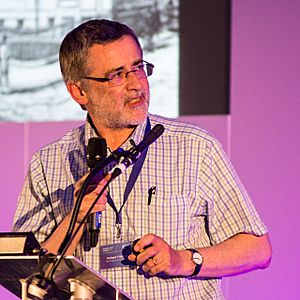Richard Treisman facts for kids
Quick facts for kids
Sir Richard Treisman
FRS FMedSci
|
|
|---|---|

Treisman in 2015
|
|
| Born | 7 October 1954 |
| Education | Haberdashers' Aske's Boys' School |
| Alma mater | Christ's College, Cambridge University College London |
| Awards |
|
| Scientific career | |
| Institutions | Francis Crick Institute Harvard University University of Cambridge Laboratory of Molecular Biology |
| Thesis | The structures of polyoma virus-specific nuclear and cytoplasmic RNA molecules (1981) |
| Doctoral advisor | Bob Kamen |
| Other academic advisors | Tom Maniatis |
| Notable students | Richard Marais |
Sir Richard Henry Treisman, born on October 7, 1954, is a British scientist. He specializes in understanding the tiny parts of cells (molecular biology) to learn about and fight cancer. Today, he is a research director at the Francis Crick Institute in London.
Contents
Learning and Early Studies
Richard Treisman went to Haberdashers' Aske's Boys' School. He then studied at Christ's College, Cambridge, earning a degree in 1977. Later, he continued his studies at the Imperial Cancer Research Fund (ICRF) and University College London. In 1981, he earned his PhD. His research focused on how certain viruses, called polyomaviruses, make copies of their genetic material (RNA).
His Work and Discoveries
After getting his PhD, Treisman did more research at Harvard University. He studied how globin genes work and learned about genes related to a blood condition called thalassemia.
In 1984, he joined the Medical Research Council (MRC) Laboratory of Molecular Biology (LMB) at the University of Cambridge. Here, he started looking into how "growth factors" control how genes are turned on or off.
Understanding Gene Control
Richard Treisman first focused on a gene called Fos. He found a special protein called Serum response factor (SRF) that helps control genes. He also figured out how to make copies of the gene for SRF. In 1988, he moved back to London.
He showed that other proteins, called TCF cofactors, work with SRF and are affected by a cell signaling path called MAPK. He also discovered that MRTF cofactors are special proteins that can sense changes in the amount of G-actin, another important cell part. He continues to study SRF and the signals that control it.
From 2000 to 2015, Treisman was the Director of the Cancer Research UK (CRUK) London Research Institute. In 2009, he also became a Research Director at the Francis Crick Institute.
Awards and Special Recognitions
Richard Treisman has received many honors for his important work:
- He became a member of the European Molecular Biology Organization in 1988.
- He was made a Fellow of the Academy of Medical Sciences (FMedSci).
- He received the EMBO Gold Medal in 1995.
- He was awarded the Louis-Jeantet Prize for Medicine in 2002.
- In 1994, he was elected a Fellow of the Royal Society (FRS).
- In 2016, he was knighted by the Queen, which means he can use the title "Sir."

